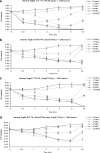Antimicrobial drug resistance of Salmonella enterica serovar typhi in asia and molecular mechanism of reduced susceptibility to the fluoroquinolones
- PMID: 17908946
- PMCID: PMC2167998
- DOI: 10.1128/AAC.00294-07
Antimicrobial drug resistance of Salmonella enterica serovar typhi in asia and molecular mechanism of reduced susceptibility to the fluoroquinolones
Abstract
This study describes the pattern and extent of drug resistance in 1,774 strains of Salmonella enterica serovar Typhi isolated across Asia between 1993 and 2005 and characterizes the molecular mechanisms underlying the reduced susceptibilities to fluoroquinolones of these strains. For 1,393 serovar Typhi strains collected in southern Vietnam, the proportion of multidrug resistance has remained high since 1993 (50% in 2004) and there was a dramatic increase in nalidixic acid resistance between 1993 (4%) and 2005 (97%). In a cross-sectional sample of 381 serovar Typhi strains from 8 Asian countries, Bangladesh, China, India, Indonesia, Laos, Nepal, Pakistan, and central Vietnam, collected in 2002 to 2004, various rates of multidrug resistance (16 to 37%) and nalidixic acid resistance (5 to 51%) were found. The eight Asian countries involved in this study are home to approximately 80% of the world's typhoid fever cases. These results document the scale of drug resistance across Asia. The Ser83-->Phe substitution in GyrA was the predominant alteration in serovar Typhi strains from Vietnam (117/127 isolates; 92.1%). No mutations in gyrB, parC, or parE were detected in 55 of these strains. In vitro time-kill experiments showed a reduction in the efficacy of ofloxacin against strains harboring a single-amino-acid substitution at codon 83 or 87 of GyrA; this effect was more marked against a strain with a double substitution. The 8-methoxy fluoroquinolone gatifloxacin showed rapid killing of serovar Typhi harboring both the single- and double-amino-acid substitutions.
Figures



References
-
- Acosta, C. J., C. M. Galindo, M. Ali, R. A. Elyazeed, R. L. Ochiai, M. C. Danovaro-Holliday, A. L. Page, V. D. Thiem, Y. Jin, J. K. Park, H. Lee, M. K. Puri, B. Ivanoff, M. D. Agtini, R. Soeharno, C. H. Simanjuntak, N. H. Punjabi, D. G. Canh, D. Sur, Q. Nizami, B. Manna, D. Bai-qing, D. D. Anh, Y. Honghui, S. K. Bhattacharya, Z. Bhutta, D. D. Trach, Z. Y. Xu, T. Pang, A. Donner, and J. D. Clemens. 2005. A multi-country cluster randomized controlled effectiveness evaluation to accelerate the introduction of Vi polysaccharide typhoid vaccine in developing countries in Asia: rationale and design. Trop. Med. Int. Health 10:1219-1228. - PubMed
-
- Ausubel, F. M., R. Brent, R. E. Kingston, D. D. Moore, J. G. Seidman, J. A. Smith, and K. Struhl. 1987. Preparation and analysis of DNA, p. 2.0.1-2.14.8. In F. M. Ausubel, R. Brent, R. E. Kingston, D. D. Moore, J. G. Seidman, J. A. Smith, and K. Struhl (ed.), Current protocols in molecular biology, vol. 1. Wiley, New York, New York.
-
- Becker, D., M. Selbach, C. Rollenhagen, M. Ballmaier, T. F. Meyer, M. Mann, and D. Bumann. 2006. Robust Salmonella metabolism limits possibilities for new antimicrobials. Nature 440:303-307. - PubMed
-
- Bhan, M. K., R. Bahl, and S. Bhatnagar. 2005. Typhoid and paratyphoid fever. Lancet 366:749-762. - PubMed
Publication types
MeSH terms
Substances
Grants and funding
LinkOut - more resources
Full Text Sources
Medical

